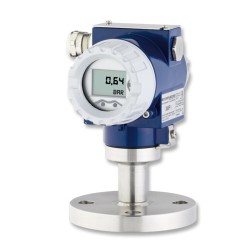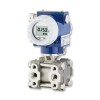 All devices connected to make up a 4 to 20 milliamp current loop are connected in series.
All devices connected to make up a 4 to 20 milliamp current loop are connected in series.
The devices that are typically connected together include:
- Pressure Transmitter
- Input Device to accept the signal from the Pressure Transmitter such as a Programmable Logic Controller (PLC), Controller, Panel Meter, Analog to Digital Converter (ADC) or Signal Conditioning Unit (SCU)
- Sensor Power Supply to power the Pressure Transmitter such as a Programmable Power Supply unit, DC Power Supply Unit (PSU), AC/DC Voltage Regulated Transformer or a DC Battery
A) If the 4-20mA Input Device includes an Internal Sensor Power Supply and has 2 input connections:
- Connect Positive (+) Input connection to Positive (+) Pressure Transmitter connection
- Connect Negative (-) Input connection to Negative (-) Pressure Transmitter connection
B) If the 4-20mA Input Device requires an External Sensor Power Supply and has 2 input connections:
- Connect Positive (+) External Sensor Power Supply connection to Positive (+) Pressure Transmitter connection
- Connect Negative (-) Pressure Transmitter connection to Positive (+) Input connection
- Connect Negative (-) Input connection to Negative (-) External Sensor Power Supply connection
C) If the 4-20mA Input Device includes an Internal Sensor Power Supply and has 2 input connections plus 2 supply connections:
- Connect Positive (+) Internal Sensor Power Supply connection to Positive (+) Pressure Transmitter connection
- Connect Negative (-) Pressure Transmitter connection to Positive (+) Input connection
- Connect Negative (-) Input connection to Negative (-) Internal Sensor Power Supply connection
Some Input Devices bridge the Negative (-) Input connection to the Negative (-) Internal Sensor Power Supply via an internal / external jumper or link.
If the input device only includes a Voltage input, it can be easily adapted to measure a 4-20mA signal by adding a 250 Ohm load resistor across the Positive (+) and Negative (-) Input connections. This will generate a voltage drop of between 1 and 5 Volts which is directly proportional to the 4-20mA signal.
Related Help Guides
- How to get a 10 volt signal from a 4-20mA output pressure sensor
- Transforming a 2 wire Current Loop into a Voltage Output Signal
- How do you measure flow rate with a dp cell
- Advantages and Disadvantages of using a 4 to 20 mA Signal
- What is difference between working, burst and over pressure
- Supply voltage and load resistance considerations for pressure transmitters
- What can cause random variation in pressure transducer output
- Why use 4-20mA and 3-15 psi rather than 0-20mA & 0-15psi
- What is the difference between a pressure transducer and a transmitter
- Does the type of Engineering Units matter for Pressure Transmitters
- Choosing calibrator for pressure transmitters
- How to create a list of specification parameters for a pressure sensor
Related Technical Terms
- 2 Wire
- 4 to 20 mA Current Loop Output Signal
- HART®
- Isolation Diaphragm
- Square Root Extraction
- Stainless Steel Pressure Sensors
- Transmitter
- Turndown Ratio
Related Online Tools
- 4-20mA Signal to Measurement Reading Converter
- SqRt Extraction 4-20mA Signal to Measurement Reading Converter
- Pressure Transmitter 4-20mA Current Output Calculator
- Temperature Transmitter 4-20mA Current Output Calculator
- Flow Transmitter 4-20mA Current Output Calculator
- Liquid Level Transmitter 4-20mA Current Output Calculator
- DP Flow Transmitter Output Calculator
- 4 to 20 mA Supply, Load, Shunt and Signal Calculator
- Pressure Transmitter 0-20mA Current Output Calculator

